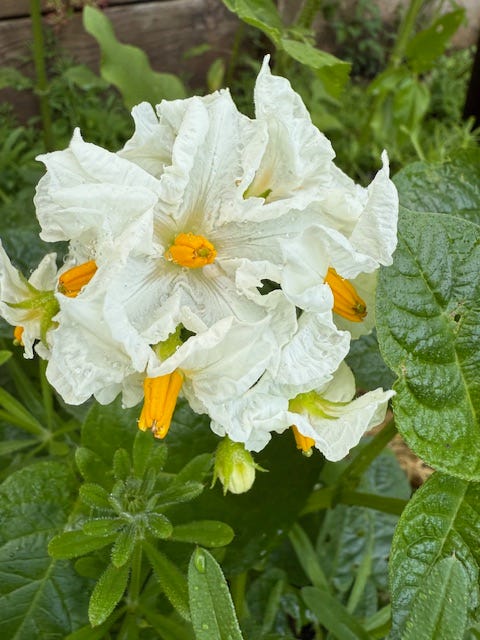July has arrived and my woody kiwi vines have been blooming for over a week. I still get giddy every year when I see their blossoms because each flower portends a small, fat, juicy, sweet-tart known as the kiwi berry.
Kiwis are native to the mountains of China and Russia and were first farmed in New Zealand in 1906. In my neck of the woods, I think of them as a practical replacement for the oranges that I can’t grow on the foggy, cool coast.
Do your kiwis always produce fruit? My neighbor’s kiwis never set fruit and she was super pissed-off.
The easiest path to get kiwis is to make sure you have perfect flowers, like mine, shown above. By perfect I mean bisexual. Woh! Bisexual is perfect? Maybe so, and definitely in the botanical world it is! A flower with both male and female parts on the SAME flower is considered both bisexual, and perfect. Nature…getting it’s freak on.
I know I will have kiwis this winter because I have perfect kiwi flowers. They are self-pollinating, even though they do benefit from cross pollination with other males.
Many people buy kiwis at a nursery not realizing they bought a male OR a female plant, and definitely not one of EACH. Plus if you have one of each, there is no guarantee that they will successfully cross-pollinate and beget kiwis. Get perfect-flowered kiwis and you won’t need to worry about it.
Another reason to have kiwis in your garden setup is that they provide Vitamin C-rich fruit (more than oranges by weight) in January through early March. Winter is an important season to boost our immune systems, and one small kiwi provides more than the daily value for Vitamin C. Grow some kiwis in your backyard and fight off covid, colds, hand-foot-mouth, or whatever the latest virus is making it’s rounds; and prevent scurvy too! Bonus!
Kiwis - now you know.
Now let’s talk potato flowers.
I have volunteer potatoes all over my garden. I’ve been growing every variety of potato over the decades, and this spring some soil that had teeny tiny seed potatoes in it from past harvests got rototilled into the main garden area. Now I have potatoes everywhere; between the corn, in the green beans, in the greenhouse in pots with the bell peppers…everywhere. This morning, I flagged them all with caution tape so I could find the potatoes when the plants die back, the intended crop is finished, and it’s finally time to harvest.
This volunteer potato plant shown above is blooming and I have no idea what kind of potato it’s attached to.
Or DO I?
Potato plants have flowers of many colors including white, pink, lavender, purple, blue, and red. Their anthers can vary in color too. The colors of the flowers and anthers can give you a hint as to the potato’s skin and flesh color.
If you discover a flowering potato with blue or red anthers this means the plant produces blue or red pigment which may be distributed to the potato as well.
Here’s a potato (above) with blue flowers and blue pigment in the anthers. I’m 99.9% certain this is attached to ‘all blue’ potatoes.
White flowers mean the the plant isn’t producing pigments, or at least it isn’t distributing them to the flower. So even if the flowers are white, it is still possible to have white/yellowish potatoes with white, yellow, blue, or red skin.
Anyhow, if you find you’ve forgotten which potatoes are where, or the garden tags have gone MIA, the flowers will give you a good idea where you put the blues, the Norton reds, or the German butterballs…







